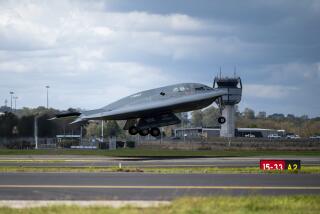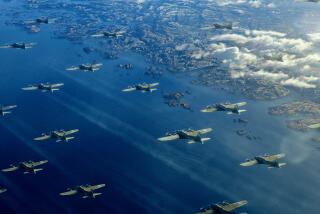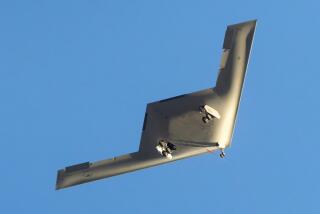A Vintage Vantage From WWII-Era Bombers
- Share via
It starts as a purr. The four propellers hum into action, two on either side of the B-17. It’s not much louder than a crowded restaurant, but there’s the shaking, like a mild earthquake that doesn’t stop.
Then, as the bomber reaches 100 mph and lifts off the runway, the rumble grows into a bone-jarring rattle. It’s as loud as being in the belly of a tank.
The bomber, built just before the end of World War II, is one of two at John Wayne Airport this month, open to the public for tours and rides. Its companion, a B-24, was restored with parts from several planes in 1989.
The event is part of an annual tour organized by the Collings Foundation, a nonprofit organization based in Stow, Mass. The foundation, supported with volunteer labor and donations, has the mission of restoring vintage warplanes to educate the public and pay tribute to those who flew them.
The B-17, named “Nine-O-Nine,” is one of seven in the country flown regularly, crewmen said. The B-24, “Dragon and His Tail,” is the only one flying in the United States.
The rides offered to the public are loops over Orange County lasting 20 to 30 minutes--a small fraction of the 10-hour missions flown in wartime. But the roar of the propellers is still there, along with the locker-room smell and tight quarters that require crawling on all fours to get around.
On Wednesday the two bombers left Riverside Municipal Airport for John Wayne Airport at 14:30 hours. Before the departure, 12 pilots and crewmen plotted strategy under the shade of the B-24’s wings.
Among them was Joe Pagani, the man who piloted the original B-24 bomber on which the restoration was modeled. The 73-year-old Orange resident remembers that in war “you don’t worry about people shooting you down. If you’re worried about that, you’re sure to be shot at. . . . You’re thinking about getting the job done.”
The first job is boarding the plane, which requires grabbing hold of an edge of the hatch, sliding into the 2-foot-square opening and hoisting yourself through.
“And once you’re in, make sure you don’t lean on the door, because they’re not made to withstand weight, and you’ll pop right out,” said Mike Walsh, the B-17 crew chief.
Inside, the quarters are cramped. Behind the pilots are a pair of crude seats for crewman--simple metal backs bolted to the wooden floor. Broad canvas seat belts hold passengers in place, but conflicting with any sense of security they provide is the rush of wind through inch-wide openings in the metal skin of the bomber.
To reach the front gun turret, below and slightly in front of the cockpit, one must crawl on hands and knees. Inside is a machine gun and replicas of the 50-caliber bullets that fed into it.
Farther back in the plane, passengers can see only through scattered small windows and a gun turret. Two replicas of 1,000-pound bombs rest above closed doors in the floor of the plane.
The only sense of being airborne is conveyed by shadows glimpsed skirting across the ground, the roar of the engines and the rocking motion.
From the cockpit, however, pilots can see the ground unfolding. Several minutes into Wednesday’s flight, over southwestern Riverside County, the view is of countless ripples forming on Lake Mathews, showing the power of the bomber and its engines.
The landing at John Wayne is surprisingly smooth. One by one, voices become audible again as the propellers slow.
Pilot Gary Thompson turns around, a wide smile stretching across his face as he lifts the American flag and hoists it out his window.
“Fortunately, we can’t re-create the scene” of air combat, said B-24 pilot Rob Collings, whose parents founded the organization. “This is more of a Disneyland version of the ride, but it gives you a feel of how loud it gets, how tight the area, and you can use your imagination to re-create the rest.”
The two bombers will be at John Wayne Airport through 1 p.m. Friday. They are open for tours for $7, and rides are offered for tax-deductible donations of $350.
More to Read
Sign up for The Wild
We’ll help you find the best places to hike, bike and run, as well as the perfect silent spots for meditation and yoga.
You may occasionally receive promotional content from the Los Angeles Times.






